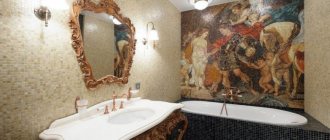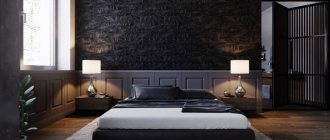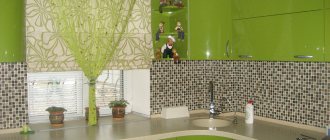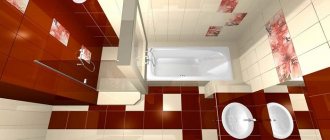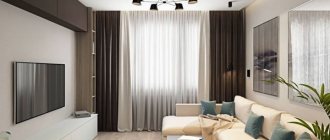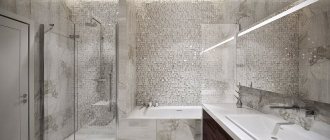Click to share
more
Light in the bathroom is an underrated interior design element - especially for small bathrooms. Light shapes space; it can also visually improve the proportions of a room and bring the desired mood to the interior. Both lighting a small bathroom without a window and a bathroom with large glazing requires thoughtful solutions. We offer you useful tips and advice on what to consider to ensure your bathroom is well lit.
What not to do
There are prohibitions for the entire premises and for its individual zones.
Restrictions according to GOSTs and SNiPs
Prohibited activities are listed in local regulations. These lists may differ in different regions, but basically they are the same. For Moscow, Resolution No. 508 PP applies. According to this document, it is prohibited to lay grooves in reinforced concrete slabs and interpanel joints.
Channels can be laid in the finishing or under a suspended ceiling or plasterboard sheathing of a metal frame.
Some restrictions are introduced by GOSTs and SNiPs. Technical standards prohibit open wiring. You can only use a triple wire with a phase, neutral and protective conductor. Each of them must be in its own protective shell. All three wires are connected together under an additional layer of insulation.
The use of metal coating without insulation is not permitted.
For laying, corrugated or plastic pipes should be used. Metal ones cannot be used. If the cable is damaged, such a coating will not be able to protect against electric shock. The use of electrical tape is not permitted.
There is no need to skimp on communications. It is better to take a thicker section so that the core does not burn out under intense loads. Typically, an aluminum cable with a cross-section of 4 mm2 or a copper cable with a cross-section of 2.5 mm2 is used. You cannot combine copper and aluminum - this will lead to a reaction between them.
It is prohibited to place switches, electrical panels and distribution boxes in the bathroom.
Sockets and all devices must have a residual current device (RCD). There are special models for wet rooms. All equipment must be grounded. To minimize the risk, even a bathtub can be grounded if it is made of steel or cast iron.
Under no circumstances should you do grounding yourself by connecting a wire to a heating radiator or water pipe. This can be dangerous to life and health.
According to the Civil Code of the Russian Federation, any changes that require inclusion in the technical passport and the BTI plan require the creation of design documentation.
Only an engineering organization with SRO approval can draw up a project. Documentation must be approved by government authorities. The installation of lighting, as a rule, cannot be classified as a refurbishment, but it may be part of a plan that requires a number of changes to be made to the layout and energy supply of the apartment.
To avoid mistakes, everything must be carefully planned and calculated before starting work. To avoid getting an electric shock, you should work with the electricity turned off.
Restrictions for individual zones
Lighting in a small bathroom, as well as in a spacious room, depends on areas with different degrees of humidity.
Four sections can be distinguished:
- The space above the bathtub, as well as inside the shower stall, where there is especially a lot of water and steam, and the humidity concentration is the highest. Here you can install lamps with a power of up to 12 W with a protection index of IP 674 or more. This parameter is always indicated on the packaging or in the instructions. The first number indicates the degree of protection against dirt. It ranges from 1 to 6. The second shows how well the product is protected from water and steam. The maximum value is 8. At this level, it can be immersed in liquid for a long time. The last number is impact resistance. It ranges from 0 to 10.
- The space adjacent to the sink and shower stall and other plumbing fixtures. Drops of water may reach here. You can use lamps with a power of up to 24 W and a degree of protection IP 452.
- An area located at a distance of 50 cm from the sink and other appliances. There are no power restrictions here anymore. The index must be at least IP 242.
- The last section is everything that comes next. Drops usually don't reach here. Moisture enters here in the form of steam and condensate. Devices with an IP rating of 011 and higher are used in this area.
This zoning applies regardless of the presence of a hood. It is suitable for separate and combined bathrooms.
Floor lighting
A very beautiful, economical and original option for lighting. But it is worth considering that such light should not be installed yourself, without special technology.
The floor always becomes damp after a shower or bath. Therefore, you should protect yourself as much as possible and install the necessary elements for waterproofing. For this method, the degree of protection must be IP67. All devices with this degree are equipped with moisture and dust resistance.
As mentioned above, this technique saves a lot of space, so it is an ideal option for lighting a small bathroom.
Also, do not forget about neon lamps. Of course, their price may be too expensive for some, but their uniqueness and long service life pay for all expenses. They can work for up to 10 years, and sometimes longer. You can choose any color of neon lamps, you can also purchase a lamp that will be controlled by a remote control.
Such lamps must be placed on the floor or wall and insulated from moisture. Designers suggest placing such lighting along the walls, away from taps.
A cheaper and more modern analogue of such lamps is LED strips. Their installation is very easy and simple. The service life is much longer than neon lamps and also less fragile. They can be used both outside and hidden in the bathroom.
How many lamps will be needed?
The number of lighting fixtures in the bathroom depends directly on its area. If the room is very tiny, and its area is about 5 m2, then a chandelier in the center of the ceiling with two or three lamps will be enough.
But even if the bathroom is small, it is better to additionally illuminate the washbasin and mirror area to make all cosmetic procedures much easier.
If the bathroom is spacious enough, then it is necessary to provide zone lighting, the features of which will depend on the configuration of the room, design ideas and some other factors.
It is important to consider a lot of other factors that affect the lighting in the bathroom. These include:
- interior style, or rather the chosen color scheme, because, as you know, light shades reflect light fluxes more, which means the room will seem more illuminated. The same can be said about glossy, mirror and glass surfaces;
- the height at which the lamps will be installed, because the closer they are to a person, the brighter the light they give;
- type of lamps.
It is better to decide on the number and location of lighting fixtures at the stage of repair work in order to avoid unnecessary hassle and waste in the future.
The influence of lighting on the functionality of the bathroom
Tiny combined bathrooms are gradually becoming history, as is a single light bulb screwed above the door or in the central part of the ceiling. To carefully consider what your bathroom lighting will be like, you just need to remember how much time we spend here and what we do.
As soon as we wake up, we rush to the bathroom. If you are the happy owner of a separate bathroom, then this room will still be among the first ones that we need to visit in the morning. After all, we are used to washing and brushing our teeth here.
Even if there is natural light in the bathroom, additional lighting fixtures should be present here in such quantities that the room is pleasant and convenient to use even in the dark
In addition, here we are:
- We take a hygienic shower. This mandatory and pleasant morning procedure can be postponed until the evening - it’s not that important.
- We bathe our children. Often such an event is accompanied by abundant foaming and swimming of favorite toys.
- Shaving - this activity requires high-quality light and is relevant for representatives of both sexes.
- We pamper ourselves with SPA treatments. In particular, we take a bath with salt, plant extract, foam and other relaxing or inspiring additions.
- We wash it. Yes, the washing machine is most often located here. Besides, sometimes you just need to quickly wash something or rinse it – it’s a matter of minutes.
- We take care of our skin and apply makeup. That is, all creams and cosmetics, as a rule, are located on the shelves of furniture that can be placed in this room.
- We treat our nails, wash our hands after visiting the toilet, returning home from the street or just because.
In general, if it is pleasant to be in a room and it pleases us with its appearance, then there will definitely be something we would like to do here.
In addition to the light that will penetrate the room from sources hidden behind the frosted glass of the wall, its space will be illuminated by a warm glow from the fireplace and candles
As you can see, the list of functions that we ourselves have assigned to this room is quite impressive. Sometimes we need a bright, directional stream of light that leaves no shadows on our image in the mirror. Another situation is associated with pleasant twilight. And for the third you will need scented candles.
Therefore, the only dim lampshade is definitely not relevant. You will need to select suitable lamps, focusing on the location area and the purpose of its installation.
What type of lamp should I choose?
Today, the choice of lighting devices is so extensive that everyone can choose the option that best suits their wishes. So, according to the type of location on the surface, lamps can be:
- open;
- built- in This option is preferable for miniature bathrooms with not very high ceilings.
Depending on the location, the lamps can be:
- ceiling _ This is a timeless classic. Each bathroom should be equipped with at least one ceiling lamp, which will be responsible for the general light in the room;
- wall- mounted These are lamps that are designed to highlight certain functional areas of the room;
- floor lamps perform more of a decorative function; they can add zest to the interior of a room and visually expand the space of the room.
Each of the lamps used can perform one or several of the following functions:
- work lighting;
- decorative lighting;
- directional lighting;
- general lighting.
, different types of lamps can be used as light sources
- incandescent lamps;
- halogen;
- luminescent;
- LED
Everyone has the right to choose the type of lamps themselves, depending on the type of lamp or their own desire to save money, but special attention should be paid to LED lamps. They are considered the most economical and safe, because they do not heat up during operation. LED strip is also often used, which adds a real zest to the bathroom interior.
The only drawback of LED lamps is their high price.
Optimal lamp type
When organizing lighting for a bathroom or toilet, you need to take into account the characteristics, pros and cons of different types of light bulbs.
There are the following types of lighting elements:
- Incandescent lamps are the most affordable light sources. However, their service life is no more than 1000 hours. They emit bright light, but heat up quickly, so they cannot be used for closed, plastic or textile shades.
- Halogen - their luminous efficiency is high, they last a long time. However, it is recommended to use them for lamps with a special metal diffuser. For lamps with a voltage of 12 V, a special step-down transformer is required, which is quite expensive.
- Luminescent - have a wide range of colors, they can emit daylight, warm or cold light. However, at low voltage they begin to glow dimly or turn off completely. In addition, their bulb is filled with mercury vapor, which is dangerous if the bulb breaks.
- An LED lamp is the best light source of all. They last about 50,000 hours, consume a minimal amount of electricity, have a wide spectrum of light, and emit a soft but bright light. Their only disadvantage is the high cost and the need to connect a power supply and dimmer. However, this disadvantage is compensated over time by saving energy.
Selecting the appropriate lighting power
Of course, there are engineering laws, formulas for calculating illumination with several variables and exact results. But in practice, the lighting intensity is rather selected by eye, based on the principles of “like-dislike”, “already annoying or still quite tolerable”.
The number of mirror and reflective (glossy) surfaces plays an important role: they visually increase illumination.
If there are many light sources, you can consult with a designer, a technical specialist, or simply on an Internet forum.
It is important to take into account sources of natural light: windows in bathrooms are not uncommon in dachas and cottages, and in city apartments there are transparent windows under the ceiling. During the daytime, they allow you to save electricity - use the bathroom without turning on the lights.
How to visually expand a bathroom
RECOMMENDED ON THE TOPIC
- Calculation of room illumination
- Is it possible to use liquid...
You can make your small bathroom look a little bigger. To do this, designers use several clever techniques with which the space noticeably expands. Properly selected finishing materials, as well as the placement of all interior details, will play a huge role in this. These small tricks will create some illusion of more space.
You should not use dark colors to decorate your bathroom. This immediately visually reduces the size of the bathroom. Any dark colors hide the volume of the room.
In small rooms, to visually increase the space, you can combine color combinations to decorate the walls. When you make one wall in a red tone, then the other can be made in white or milky tones. Only this technique will visually increase the space.
What interior styles are most close to you?

